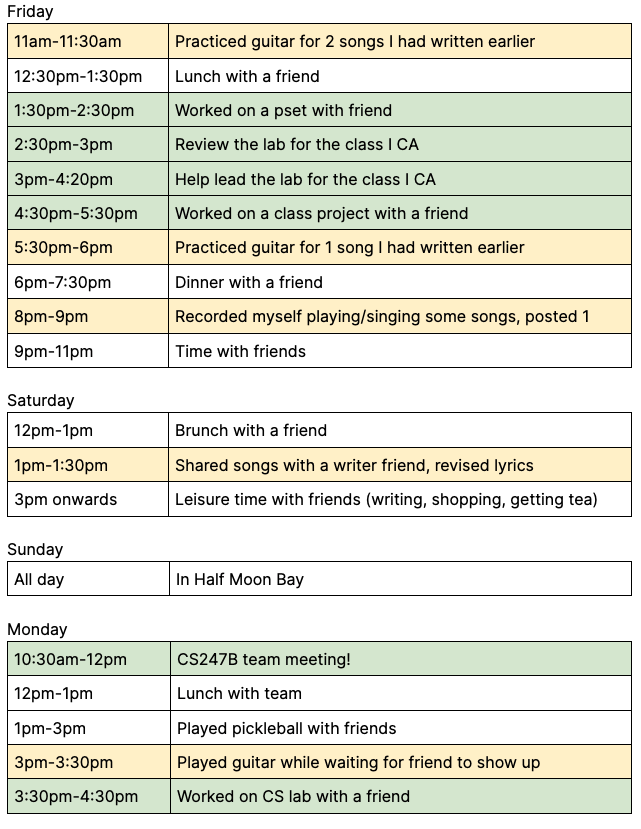Time to measure myself again! The behavior I was trying to change was becoming more consistent in making music. This includes practicing guitar for the songs I write, writing down poems or lyrics, crafting melodies, and so on — dedicated time during which I am working on my own songs.
Log of behavior
I initially tried writing something down every hour, but found that there were nuances within those hours or multiple hours with the same activity that was unrelated to my chosen habit. And so, I changed it to an approach that Krishnan mentioned in class that focused on the key events. After looking at these key events, I grouped them into 3 categories: time spent on my behavior is highlighted in yellow, working on class or homework matters is highlighted in green, and social or leisure time is left in white. Below is my log from last Friday to Monday:

Reflection on the experience
I am so much more aware of the way I divide my time when I am logging myself. What’s unusual, though, is that the times during which I engaged in my behavior were some of the only times I wasn’t thinking about logging what I was doing. I think a huge part of this is the nature of the behavior itself — I always feel very immersed when working on songs. Only after I put down the pen or the guitar and ran to my next event would I remember to log my period of songwriting.
A super interesting tendency I found after looking at my log was that it was very common for me to songwrite immediately before a planned commitment, whether that was meeting a friend for a meal or running to a meeting. If I had to predict before doing this exercise, I would expect that I would songwrite when I had the most free time, but that wasn’t true: I actually tended to songwrite when I knew there was a definite backend to the period. This is leading me to rethink the way I view the idea of getting a “creative spark” and reframing the idea that more free time means more songwriting capacity.
To be totally frank, I wasn’t sure that drawing out mental models would add too many more layers to analyzing my behavior. I was wrong! And I’m very happy I was. Particularly, the causality connection circle showed me a lot of new insights about the relationships between factors such as time in my room, busyness of the day, creativity, bandwidth, and so on. My two mental models (the iceberg model and a connection circle) are shown below:
Mental models

If I were to do this again…
I would try out a regular time interval and not be afraid to write something simple as “same as above,” even if it felt trivial at the time. I’m sure that data would show me a lot about exactly how I split the time in my day, especially since I put “time in room” and “busier day” as two factors in my connection circle.
I’d also be interested in dividing my behavior into more specific activities, perhaps drawing a line between writing something new and practicing something I’ve already written and strictly working on guitar skills.



